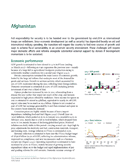ADB: Afghanistan Outlook for 2012
Full responsibility for security is to be handed over to the government by end-2014 as international troops are withdrawn. Since economic development (as well as security) has depended heavily on aid and international military spending, the transition will require the country to find new sources of growth and ways to achieve fiscal sustainability, in an uncertain security environment. These challenges will require major domestic efforts and reforms alongside substantial external support by donors if development momentum is to be sustained.
GDP growth is estimated to have slowed to 5.7% in FY2011 (ending 20 March 2012) – following an 8.4% expansion the previous year – mainly because of a large fall in agricultural food grain production owing to unfavourable weather conditions for a second year.
Private consumption remained the main source of economic growth, fuelled by the large aid inflows that underpin most of the demand for goods and services. Growth in services activity, which accounted for 53% of GDP, moderated during the year, reflecting lower foreign inflows. Domestic investment is estimated at 22.6% of GDP, including private investment of just over a third of that.
Economic activity will continue to be driven mainly by consumption expenditure and is expected to pick up to 7.1% in FY2012 (assuming more favourable weather for agriculture). A slowdown to 5.8% is expected in FY2013, though, because of declining local spending from foreign security forces as they gradually withdraw and waning grant-financed development spending that is not channelled through the government budget. An economic program with the IMF under its Extended Credit Facility was agreed in November 2011 and it provides an overall macroeconomic adjustment framework for the next 3 years, as well as guidance to reform banking regulations after the failure of Kabul Bank

